UK | Sustainability | Field Notes and Photography | Original Content
Don't wanna be here? Send us removal request.
Text
I am finally moving somewhere with a garden and I have great plans to rewild it! I have a little slot of land here which I can use to help the local wildlife! I will post my ventures in this.
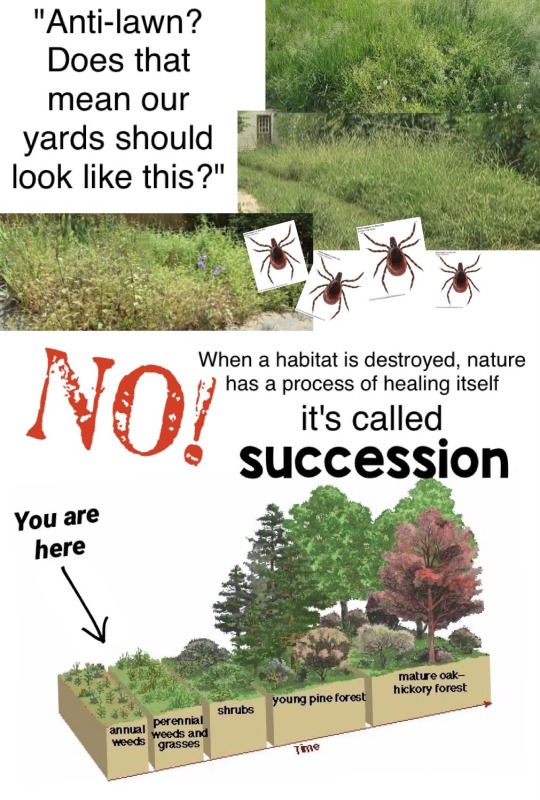
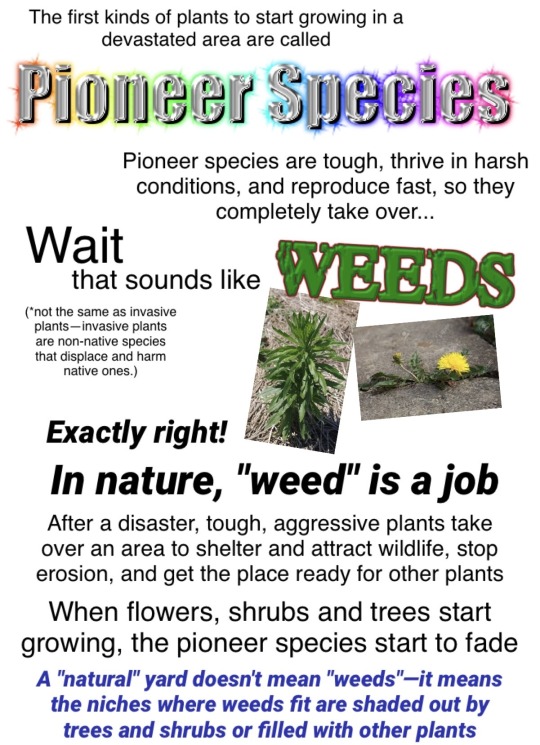

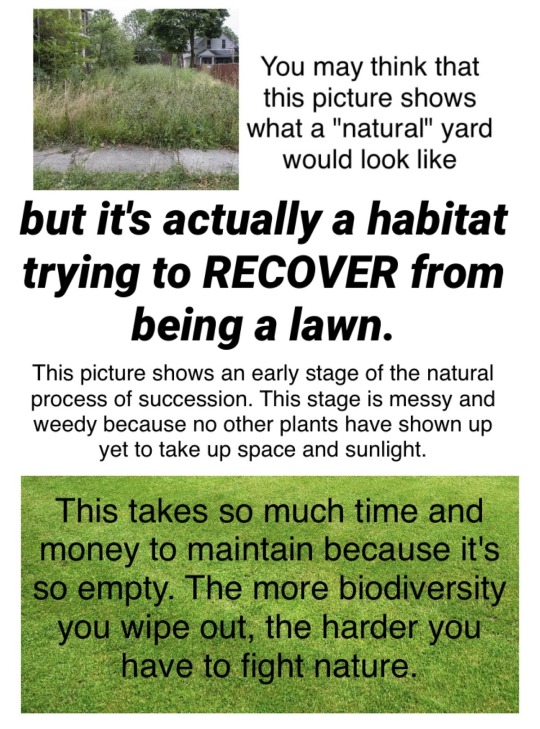
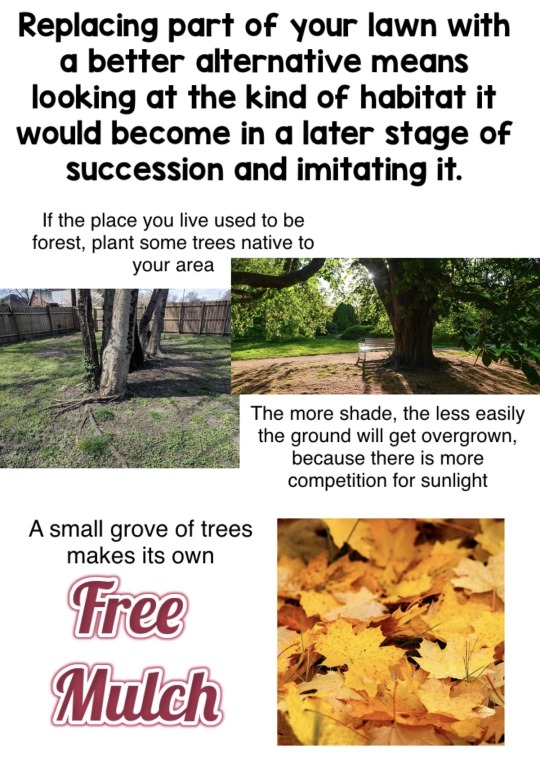

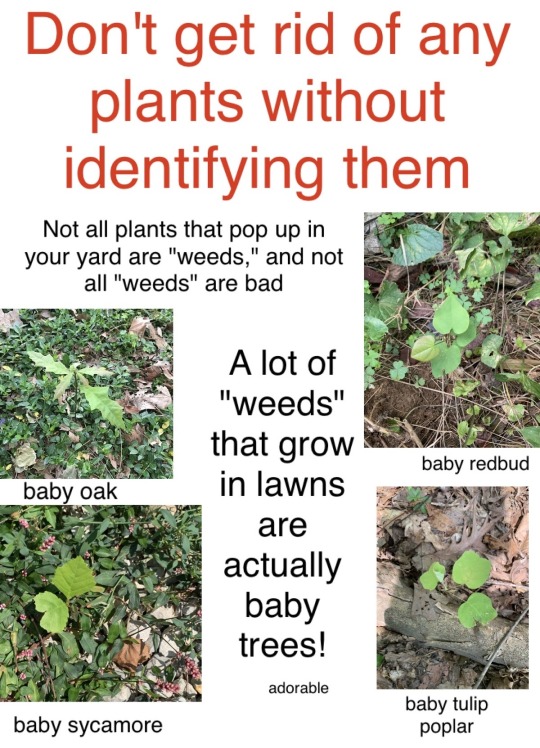
I...tried to make a meme and got carried away and made A Thing that is like partially unfinished because i spent like 3 hours on it and then got tired.
I think this is mostly scientifically accurate but truth be told, there seems to be relatively little research on succession in regards to lawns specifically (as opposed to like, pastures). I am not exaggerating how bad they are for biodiversity though—recent research has referred to them as "ecological deserts."
Feel free to repost, no need for credit
#conservation#ecology#environment#solar panels#restoration ecology#rewilding#gardening#garden#sustainability
215K notes
·
View notes
Text
"People have been telling stories about renewable energy since the nineteen-seventies, when the first all-solar-powered house opened on the campus of the University of Delaware, drawing a hundred thousand visitors in 1973, its first year, to marvel at its early photovoltaic panels and its solar hot-water system, complete with salt tubs in the basement to store heat overnight. But, even though we’ve got used to seeing solar panels and wind turbines across the landscape in the intervening fifty years, we continue to think of what they produce as “alternative energy,” a supplement to the fossil-fuelled power that has run Western economies for more than two centuries. In the past two years, however, with surprisingly little notice, renewable energy has suddenly become the obvious, mainstream, cost-efficient choice around the world. Against all the big bad things happening on the planet (and despite all the best efforts of the Republican-led Congress in recent weeks), this is a very big and hopeful thing, which a short catalogue of recent numbers demonstrates:
It took from the invention of the photovoltaic solar cell, in 1954, until 2022 for the world to install a terawatt of solar power; the second terawatt came just two years later [in 2024], and the third will arrive either later this year or early next [in 2025 or early 2026].
That’s because people are now putting up a gigawatt’s worth of solar panels, the rough equivalent of the power generated by one coal-fired plant, every fifteen hours. Solar power is now growing faster than any power source in history, and it is closely followed by wind power—which is really another form of energy from the sun, since it is differential heating of the earth that produces the wind that turns the turbines.
Last year, ninety-six per cent of the global demand for new electricity was met by renewables, and in the United States ninety-three per cent of new generating capacity came from solar, wind, and an ever-increasing variety of batteries to store that power.
In March, for the first time, fossil fuels generated less than half the electricity in the U.S. In California, at one point on May 25th, renewables were producing a record hundred and fifty-eight per cent of the state’s power demand. Over the course of the entire day, they produced eighty-two per cent of the power in California, which, this spring, surpassed Japan to become the world’s fourth-largest economy.
Meanwhile, battery-storage capability has increased seventy-six per cent, based on this year’s projected estimates; at night, those batteries are often the main supplier of California’s electricity. As the director of reliability analysis at the North American Electric Reliability Corporation put it, in the CleanTechnica newsletter, “batteries can smooth out some of that variability from those times when the wind isn’t blowing or the sun isn’t shining.” As a result, California is so far using forty per cent less natural gas to generate electricity than it did in 2023, which is the single most hopeful statistic I’ve seen in four decades of writing about the climate crisis.
Texas is now installing renewable energy and batteries faster than California; in a single week in March, it set records for solar and wind production as well as for battery discharge. In May, when the state was hit by a near-record-breaking early-season heat wave, air-conditioners helped create a record demand on the grid, which didn’t blink—more than a quarter of the power came from the sun and wind. Last week’s flooding tragedy was a reminder of how vulnerable the state is to extreme weather, especially as water temperatures rise in the Gulf, producing more moisture in the air; in late June, the director of the state’s utility system said that the chances of emergency outages had dropped from sixteen per cent last summer to less than one per cent this year, mostly because the state had added ten thousand megawatts of solar power and battery storage. That, he said, “puts us in a better position.”
All this is dwarfed by what’s happening in China, which currently installs more than half the world’s renewable energy and storage within its own borders, and exports most of the solar panels and batteries used by the rest of the world. In May, according to government records, China had installed a record ninety-three gigawatts of solar power—amounting to a gigawatt every eight hours. The pace was apparently paying off—analysts reported that, in the first quarter of the year, total carbon emissions in China had actually decreased; emissions linked to producing electricity fell nearly six per cent, as solar and wind have replaced coal. In 2024, almost half the automobiles sold in China, which is the world’s largest car market, were full or hybrid electric vehicles. And China’s prowess at producing cheap solar panels (and E.V.s) means that nations with which it has strong trading links—in Asia, Africa, South America—are seeing their own surge of renewable power.
In South America, for example, where a decade ago there were plans to build fifteen new coal-fired power plants, as of this spring there are none. There’s better news yet from India, now the world’s fastest-growing major economy and most populous nation, where data last month showed that from January through April a surge in solar production kept the country’s coal use flat and also cut the amount of natural gas used during the same period in 2024 by a quarter. But even countries far from Beijing are making quick shifts. Poland—long a leading coal-mining nation—saw renewable power outstrip coal for electric generation in May, thanks to a remarkable surge in solar construction. In 2021, the country set a goal for photovoltaic power usage by 2030; it has already tripled that goal.
Over the past fifteen years, the Chinese became so skilled at building batteries—first for cellphones, then cars, and now for entire electric systems—that the cost of energy storage has dropped ninety-five per cent. On July 7th, a round of bidding between battery companies to provide storage for Chinese utilities showed another thirty per cent drop in price. Grid-scale batteries have become so large that they can power whole cities for hours at a time; in 2025, the world will add eighty gigawatts of grid-scale storage, an eightfold increase from 2021. The U.S. alone put up four gigawatts of storage in the first half of 2024.
There are lots of other technologies vying to replace fossil fuels or to reduce climate damage: nuclear power, hydrogen power, carbon capture and storage; along with renewables, all were boosted by spending provisions in Biden’s Inflation Reduction Act and will be hampered to varying degrees by congressional rollbacks. Some may prove useful in the long run and others illusory, but for now they are statistically swamped by the sheer amount of renewable power coming online. Globally, roughly a third more power is being generated from the sun this spring than last. If this exponential rate of growth can continue, we will soon live in a very different world.
All this suggests that there is a chance for a deep reordering of the earth’s power systems, in every sense of the word “power,” offering a plausible check to not only the climate crisis but to autocracy. Instead of relying on scattered deposits of fossil fuel—the control of which has largely defined geopolitics for more than a century—we are moving rapidly toward a reliance on diffuse but ubiquitous sources of supply. The sun and the wind are available everywhere, and they complement each other well; when sunlight diminishes in the northern latitudes at the approach of winter, the winds pick up. This energy is impossible to hoard and difficult to fight wars over. If you’re interested in abundance, the sun beams tens of thousands of times more energy at the earth than we currently need. Paradigm shifts like this don’t come along often: the Industrial Revolution, the computer revolution. But, when they do, they change the world in profound and unpredictable ways...
In retrospect, it’s reasonably easy to see how fast solar and wind power were coming. But, blinkered by the status quo, almost no one actually predicted it. In 2009, the International Energy Agency predicted that we would hit two hundred and forty-four gigawatts of solar capacity by 2030; we hit it by 2015. For most of the past decade, the I.E.A.’s five-year forecasts missed [underestimated the amount of renewables] by an average of two hundred and thirty-five per cent. The only group that came even remotely close to getting it right was not J. P. Morgan Chase or Dow Jones or BlackRock. It was Greenpeace, which estimated in 2009 that we’d hit nine hundred and twenty-one total gigawatts by 2030. We were more than fifty per cent above that by 2023. Last summer, Jenny Chase, who has been tracking the economics of solar power for more than two decades for Bloomberg, told the Times, “If you’d told me nearly 20 years ago what would be the case now, 20 years later, I would have just said you were crazy. I would have laughed in your face. There is genuinely a revolution happening.”
-via The New Yorker, July 9, 2025
4K notes
·
View notes
Text
I'm sorry, it's called scrambled egg lichen? that's amazing.
Babe, can you scramble my lichen for me? 🥺
This is such a cool story! Conservation of endangered species cants heavily toward animals and then plants, but you rarely see efforts to try to help endangered fungi, lichenized or otherwise. Part of this is because many fungi are very difficult to propagate, particularly those that have mycorrhizal relationships with plants, and so the best way to save them is to protect critical habitat for those species. Moreover, fungi that produce fruiting bodies like mushrooms are only really easy to observe during their relatively short fruiting season, so unless you're searching the soil or other substrate for DNA traces, your window to actually survey rare fungi is quite short.
But lichens are different. They persist year after year, and so are easier to observe. Growing them is another story, though; most people who give it a try put fragments of a given lichen on a favorable substrate in a controlled environment and hope for the best. However, success is relatively rare in the long term as lichens are quite persnickety about their growing conditions.
So what about just moving the whole substrate? If you have lichens that conveniently grow on tree branches you could cut off piece of branch and then attach them to branches of the same species of tree elsewhere at the same height/sun exposure/humidity level, and hope that the lichens continue to produce spores that then find favorable substrates locally. But it's tougher to chip off chunks of rock and move them to new places, especially if you don't want them getting kicked around.
So it's really fascinating that these conservationists tried out all sorts of different glues to find the most lichen-friendly ones, and then glued them to new substrates in old parts of their range in the hope that they'll use their rhizines to attach themselves to their new homes. It shows how much detail we have to go into in habitat restoration and species conservation to try to replicate the best conditions for a given species to thrive, and how we can't just offer degraded habitats to our wildlife of various sorts and hope that they find it acceptable. Lichens like various Parmelia species or Evernia prunastri may not be as picky in their substrates, but for a rarer species like Gyalolechia fulgens, our task is to give them their Goldilocks substrate--just right. And sometimes helping them along involves a little bookbinding glue.
#lichens#fungi#endangered species#extinction#conservation#restoration ecology#habitat restoration#nature#wildlife#environment#environmentalism#scicomm#good news#positive news#bookbinding#books#ecology#hopepunk#thats actually so cute#funny
2K notes
·
View notes
Text
Why are eco solutions so cool tho
From the article:
Unlike the flat, lifeless surfaces of typical concrete seawalls, each BIOCAP tile is designed with shaded grooves, crevices and small, water-holding pockets. These textured features mimic natural shoreline conditions and create tiny homes for barnacles, oysters, sponges and other marine organisms that filter and improve water quality. The tile’s swirling surface patterns increase the overall surface area, offering more space for colonization. The shaded recesses are intended to help regulate temperature by providing cooler, more stable microenvironments. This thermal buffering can support marine life in the face of rising water temperatures and more frequent heat events driven by climate change. Another potential benefit of the tiles is reducing the impact of waves. When waves hit a natural shoreline, their energy is gradually absorbed by irregular surfaces, tide pools and vegetation. In contrast, when waves strike vertical concrete seawalls, the energy is reflected back into the water rather than absorbed. This wave reflection – the bouncing back of wave energy – can amplify wave action, increase erosion at the base of the wall and create more hazardous conditions during storms. The textured surfaces of the BIOCAP tiles are designed to help diffuse wave energy by mimicking the natural dissipation found on undisturbed shorelines.
#ecology news#conservationart#science news#shark#marine animals#marine biology#good news#environmental news#climate solutions#ecology#habitat restoration#restoration ecology#restoration#science
3K notes
·
View notes
Text
I really believe that the all or nothing mentality isn't helpful! As much as I want nothing more but to live in a world with no concrete or plastic 😭 We can find solutions that work for our current society too! This is a huge win.

https://www.euronews.com/green/2024/12/29/the-japanese-micro-forest-method-is-transforming-cities
The Japanese ‘micro-forest’ method is transforming cities
15K notes
·
View notes
Text
we gorge with such greed;
stuffing the mouth
of the ever ticking clock
every second whispering that one day
we will all fall to the earth
and the worms will eat our eyes
we become one with the soil;
we drenched in poison.
fed to the ancient fungi;
we so greedily ate of.
may we wonder why we spent so long
ruining what we were made from.

Original Content. Never AI.
#eco poetry#conservation#environment#ecology#poetry#poets on tumblr#original poem#writing#reblog#my poem#writeblr#writers on tumblr#ecopunk#sustainability#original poetry#biology#botany#bugblr#worms#wormblr#fungi#fungus#mushrooms#mycology#environmentalism#climate change#climate crisis#gardening#ecology news
4 notes
·
View notes
Text
When you find something cool in nature but then your camera dies...

#field work#nature#nature lovers#photography#nature photography#landscape photography#ecology#relatable#camera#animal lover#environment#conservation
5 notes
·
View notes

